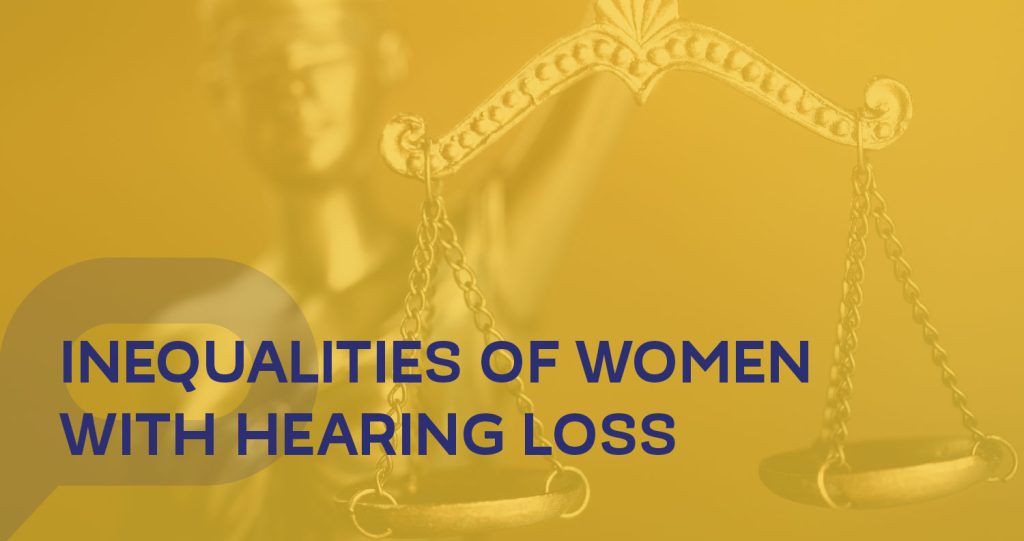Inequalities of Women With Hearing Loss
Did you know Whoopi Goldberg, Halle Berry, Jodie Foster, and Holly Hunter all have hearing loss? Berry, a domestic violence victim, suffered hearing loss after a former boyfriend struck her in the head. Goldberg, who wears hearing aids, attributes her hearing loss to years of listening to loud music. Hunter said a case of mumps as a child caused deafness in her left ear, and Foster believes her hearing loss may be linked to vertigo.
These powerhouse women have learned to live with hearing loss, and their stories reveal the reason for hearing loss can be complex. Although hearing loss is more common among men, women face some unique challenges and inequities related to hearing loss.
Women and hearing loss
In particular, hearing loss can negatively affect women in personal relationships, employment, and overall health. Domestic violence victims may have trouble successfully communicating or defending themselves against an abusive partner. The link between hearing loss and other chronic diseases has been well-established, posing additional complications for women.
And while hearing devices benefit cognitive function, and accommodations such as captioning are available and improve quality of life, many women suffer in silence due to abusive relationships, lack of education, or limited access to resources.
March is Women’s History Month and also celebrates International Women’s Day. Here are some ways hearing loss disproportionately impacts women and children.
- 1 out of 8 women report they have at least some trouble hearing (CDC)
- 1 in 4 deaf women are victims of domestic violence. (ADWAS)
- 1 in 3 deaf women are the victims of sexual assault. (ADWAS)
- 2 published statistics for abuse of girls rate between 55% and 91% of deaf girls faced sexual abuse and reported the abuse.
- 50% of deaf children are sexually abused. (UNC)
- 6% of deaf children are physically abused. (UNC)
- 26% of deaf children are neglected. (UNC)
Relationship issues
Women with hearing loss are vulnerable in several ways.
- Hearing loss, especially untreated hearing loss, magnifies communication issues.
- Women who are hard of hearing may endure verbal and emotional abuse or have little warning of a verbal or physical assault.
- Low self-esteem can keep them from standing up for themselves or seeking help.
- They may struggle to find employment, making them financially dependent on a partner and less apt to leave.
- They may become victims of sex trafficking, sexual assault, or other exploitive relationships.
This has various socioeconomic implications as well. One national study found hearing loss is associated with low educational attainment, lower incomes, and underemployment or unemployment in US adults.
There are several national resources for domestic violence victims and survivors. The Abused Deaf Women’s Advocacy Services provides comprehensive services for deaf and deaf/blind survivors of domestic violence, sexual assault, and harassment. The organization also operates a National Deaf Domestic Violence Hotline, available to deaf callers across the country.
Workplace disparities
Even without a disability, women face obstacles and inequalities in the workplace. The gender gap is real. There are known inequalities related to pay, advancement opportunities, and social/political stature.
According to Deaf People and Employment in the United States: 2019, a report published by the National Deaf Center on Postsecondary Outcomes, significant employment gaps exist for deaf and hard of hearing individuals. According to the report’s co-author in this release, they often lack employment options, are hired to do low-level jobs, or enter workplaces with few accommodations and low expectations.
- Only 53.3% of deaf people ages 25-64 were employed in 2017, compared to 75.8% of hearing people – an employment gap of 22.5%
- Employment rates have not increased from 2008 to 2017 for deaf Americans, a population that has yet to recover from the recession in 2008
- Employment and wage gaps get larger when factors such as race, ethnicity, gender, and disability are considered. Labor force participation rates vary greatly by gender (61.1% of deaf men vs. 50.5% of deaf women).
Women who are hard of hearing encounter added barriers at work. Many women fear speaking up, whether to ask for a raise or necessary accommodations to do their job effectively. They may experience implicit biases, discrimination, and social isolation.
And it’s been estimated people with hearing loss may lose as much as $30,000 a year in income, according to an article in The Tennessean. Captioning services fall under reasonable accommodations, and this blog offers tips on how to talk to your boss about captioning.
Emotional wellbeing
Isolation, depression, anxiety, and fatigue can manifest as a result of untreated hearing loss. Older women who live alone may fear not hearing an intruder, missing the doorbell or a phone call, or watching television. Also, hearing loss can lead to miscommunication, frustration, and sadness.
Researchers have established a connection between hearing loss and depression, along with hearing impairment and overall mental health.
- Women experience depression at twice the rate of men. Studies have shown people with hearing loss – particularly women – are twice as likely to develop depression than those without hearing loss.
- Some people feel left out or frustrated when they can’t follow or participate in a conversation, Zoom meetings, or special events.
- Other studies indicate a loss in brain function and memory and that the brain may be rewired by hearing loss.
Health outcomes
One of the more serious consequences of hearing loss for women is in the way of health. Hearing loss is linked to many chronic physical health issues, which are more commonly diagnosed in women.
Researchers have linked hearing loss with more serious conditions such as heart disease, breast cancer, osteoporosis, diabetes, and autoimmune diseases. In fact, a decline in hearing may be an early sign of cardiovascular problems, and people with diabetes are twice as likely to develop hearing loss.
- Heart disease is the leading killer of women. One study at Medical College in Milwaukee, Wisconsin, found a significant association between low-frequency hearing loss and cardiovascular disease and associated risk factors.
- Breast cancer is much more common in women. Cancer of the ear, brain, breast, lung, and kidney can lead to hearing loss.
- Menopause and osteoporosis, also more common in women, and are linked to hearing loss. According to a study published in the Journal of Clinical Endocrinology and Metabolism, people with osteoporosis are 76 percent more likely to develop sudden sensorineural hearing loss. Other studies have found links to osteoporosis and gradual hearing loss.
- Autoimmune diseases are also more prevalent among women. Diabetes, anemia, and rheumatoid arthritis have been associated with hearing loss. RA affects more women than men, and a recent study found those with RA are more likely to develop hearing loss.
Addressing the inequality
Hearing loss, especially if it goes untreated, can have a profound impact on quality of life. It affects relationships, careers, and mental and physical health. Women often put others first and overlook their own self-care, but they can pay a very high price to ignore their hearing health. That includes enduring discrimination and abuse at work and home.
The good news is hearing devices such as hearing aids and other adaptive equipment can be game-changers. They improve cognitive function, self-esteem, and overall wellbeing. Research also indicates women are more likely to seek treatment sooner, wear their hearing aids longer, and on a more regular basis than their male counterparts.
Captioning services also help people with hearing loss stay engaged and succeed at work and home. Visit Caption Pros to learn more about our award-winning captioners and services.







